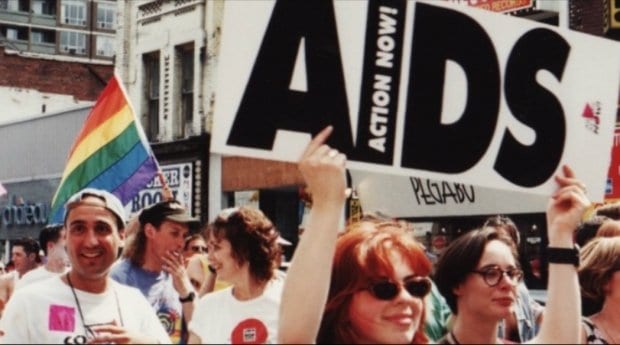Thirty years ago, a dramatic movement erupted on the Canadian scene as people with AIDS demanded treatment, an end to stigma and a host of revolutionary innovations, many of which we take for granted today.
That period of AIDS activism is now the subject of a major historical investigation that is plumbing the memories of those who were involved at the time. The AIDS Activist History Project, headed by Carleton University sociologist Alexis Shotwell, has begun interviewing AIDS activists across Canada and collecting documentary materials. Her research partner is Gary Kinsman, retired Laurentian University sociologist and one of Canada’s leading scholars on LGBT history.
The project, which is funded by a federal grant from the Social Sciences and Humanities Research Council, aims to fill a void in Canada. It is modelled in part on the ACT UP Oral History Project in New York, which documents the strategies and motivations of the AIDS Coalition to Unleash Power, the most visible direct-action AIDS activist group of that era.
“I wanted to get a little sense of what had happened here in the Canadian context,” Shotwell says. “It’s been so incredible and inspiring to just understand a little bit — we’re just starting to see the scope of what people did.” The first wave of interviews has been completed and the project is looking for individuals who were involved in AIDS activism anywhere in Canada during the period roughly 1985 to 1996.
Shotwell is emotional when speaking about the initial findings. “The first thing is this amazing lesson about the way ordinary people can just become so extraordinary and that through meeting the world as it is, incredibly difficult and tragic, can do extraordinary things,” she says.
While the first goal of the movement — which included groups like AIDS Action Now in Toronto and ACT UP groups across the country — was to demand treatments and legal protections for people with HIV and AIDS, its lasting impacts have been wide-ranging.
When drug treatments became available, they were prohibitively expensive, sometimes running $10,000 a month. “People were dying not because the drugs weren’t there, but because they couldn’t afford them,” Shotwell says.
AIDS activists demanded government funding for treatments — not only for people with AIDS but for all Canadians with catastrophic diseases, she says. This is one of the legacies of that era.
While fighting for treatment, activists were also running rearguard against reactionary governments in BC and elsewhere that promulgated legislation to permit the quarantining of people with HIV.
Shotwell is impressed that the activists who survived that era have since permeated diverse realms of Canadian policy and activism. From their collected “ephemera” — photo albums, leaflets, calls to action, meeting minutes — Shotwell says she can also see unprecedented creativity in their activism.
“They’re doing it with humour and innovation, so it’s really pretty amazing to be reminded of how creative and cool people are,” she says.
Shotwell’s co-investigator Kinsman explains that the poignancy of many of the stories recorded so far come from the confluence of grief and anger.
“People are caring for somebody who’s dying and at the same time going to meetings and at the same time organizing demonstrations,” he says. “You had a really heightened sense of awareness, consciousness and activity during this period of time because people knew that what they did really mattered.”
While some of the in-your-face strategies of the activist groups were controversial, Kinsman contends that even moderate AIDS service organizations understood they were benefitting from them. “There was a recognition that, even for the more moderate AIDS groups, that it was really important for them to be able to point out and say, ‘you know if you’re not going to deal with us — we are being moderate and nice here — you’re going to have to deal with the more activist element of our movement.’
“And that, I think, was actually a profound point of leverage for the more moderate AIDS group to get more of what they needed . . . The spread of AIDS activism was sometimes able to get results that the moderate AIDS groups on their own would never been able to get.”
The AIDS Activist History Project is online at aidsactivisthistory.ca and the investigators urge anyone with a story to tell to contact them.

 Why you can trust Xtra
Why you can trust Xtra


